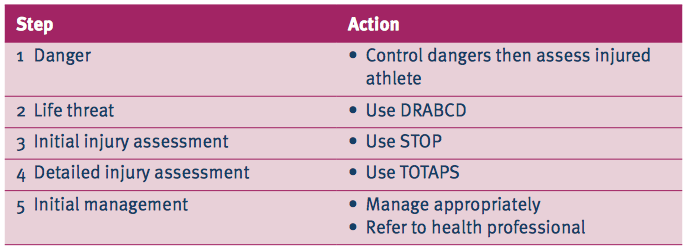In the assessment of injuries in the sport context there are three step-by-step procedures that are used and overlap with each other. There is the first aid DRSABCD procedure, the on field STOP and the off field complete assessment TOTAPS.
DRSABCD is followed before any specific assessment of injury occurs. The person assessing the injury should first check for danger to themselves, by-standers and then the casualty. They then look for a response from the athlete and, provided there is a response, then progress through STOP (Stop, Talk, Observe, Prevent further injury). If there is no response then the assessor should continue through SABCD.
STOP is an on-field assessment done to quickly assess the injury and determine if further assessment is required or if the athlete can continue to play. Stop means that the athlete is stopped from further participating, and the game is only stopped if necessary. You then Talk to the athlete determine what happened, how it happened? Where it hurts? etc. While talking to the athlete you Observe the area and the athlete. From this fast on-field assessment the assessor determines if the athlete can continue or if they need to be taken off for further assessment. The P, stands for preventing further injury, which comes by taking the player off for further assessment if required.
An example of STOP being applied, is if a Rugby League player has suffered a contusion (cork) and is limping. The Sports Trainer will come on to the field and talk to the player behind the play and find out what happened, and have a look to see if the player needs to come off. After a short conversation and observation it can be quickly determined that the athlete can continue to play, or if they need to be taken for further assessment in order to prevent further injury.
If they determine from STOP that further assessment is required, then the TOTAPS protocol (Talk, Observe, Touch, Active and Passive movement, Skills test) is used. The assessment of the injury usually begins by talking to the athlete about the injury, and progresses through the rest of TOTAPS stopping as soon as there is an indication that the player should not continue to play. (note that this is different to return to play)
Specific assessment of injuries follows the TOTAPS protocol (Talk, Observe, Touch, Active and Passive movement, Skills test), which helps to determine the nature and extent of the injury. This will include working out the type of injury, including which body part is injured, and then how bad this injury is.
It is important that this assessment happen quickly, but also that the athlete and the person doing the assessment know that this is a precautionary assessment, not a complete medical assessment, which should be sought if needed.
Students learn about:
- assessment of injuries
- TOTAPS (Talk, Observe, Touch, Active and Passive movement, Skills test)
Students learn to:
- perform assessment procedures to determine the nature and extent of injury in simulated scenarios.
References
[1] Sports Medicine Australia (2016). Sports Medicine for Sports Trainers, 10th Ed. Mosby (pg 59).
[2] Stan Browne, Deb Clarke, Peter Henson, Frida Hristofski, Vicki Jeffreys (2009). PDHPE Application and Inquiry, 2nd Edition HSC. Oxford University Press (pg 298).
Past HSC PDHPE Exam Questions (2012-2022)
2011 Question 29
(a) (ii) Describe the assessment procedure used to determine the nature and extent of a sports injury. 5 Marks
2019 Question 30
(a) An athlete dives towards the ground in an attempt to score a try in a game of touch football. The athlete hears a loud crack and remains on the ground, clutching the injured shoulder.
(i) Explain the assessment procedures that should be used to determine the nature and extent of this injury. 4 marks

![Principles for managing injured athletes [1]](https://www.pdhpe.net/wp-content/uploads/2016/01/Principles-for-managing-injured-atheltes.png)
